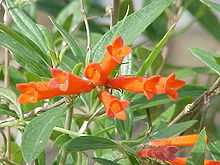Bouvardia
| Bouvardia | |
|---|---|
 | |
| Bouvardia ternifolia | |
| Scientific classification | |
| Kingdom: | Plantae |
| (unranked): | Angiosperms |
| (unranked): | Eudicots |
| (unranked): | Asterids |
| Order: | Gentianales |
| Family: | Rubiaceae |
| Subfamily: | Rubioideae |
| Tribe: | Spermacoceae |
| Genus: | Bouvardia Salisb. |
| Synonyms | |
|
Aeginetia Cav. | |
| Wikimedia Commons has media related to Bouvardia. |
| Wikispecies has information related to: Bouvardia |
Bouvardia is a genus of flowering plants in the Rubiaceae family. It contains about 30 species of evergreen herbs and shrubs native to tropical America. The genus is named in honor of Charles Bouvard (1572–1658), physician to Louis XIII, and superintendent of the Jardin du Roi in Paris.[1]
Description
They grow to 0.6-1.5 m tall. The leaves are opposite or in whorls of 3-5, ovate to lanceolate, 3–11 cm long. The flowers are in terminal, generally many-flowered clusters; the corolla has a large tube and four spreading lobes; flower colour ranges varies between species, with white, yellow, pink, and red all found.
Cultivation and Use
Several species of Bouvardia are grown as ornamental plants, both in the tropics and indoors as houseplants in temperate regions. Several cultivars and hybrids have been selected. When grown as houseplants, a minimum winter temperature of 7 °C is required, with a minimum of 12 °C while in flower. Propagation of the cultivars is by cuttings taken in late spring or summer, which need to be kept at a temperature of 20 °C by night and 25 °C during the day, and shaded when required.
References
- ↑
 "Bouvardia". New International Encyclopedia. 1905.
"Bouvardia". New International Encyclopedia. 1905.